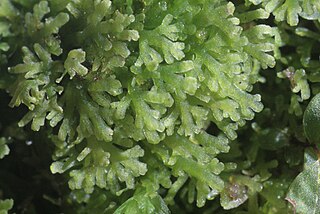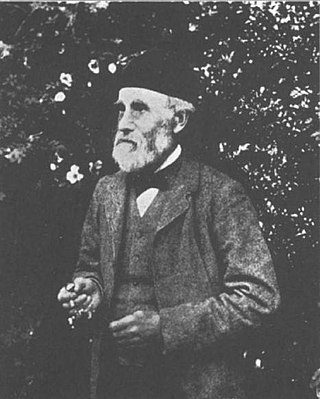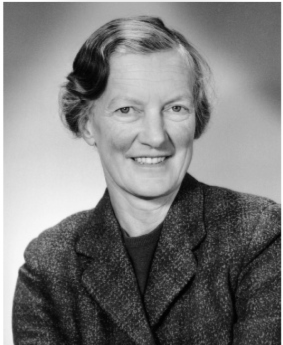Related Research Articles

The Marchantiophyta are a division of non-vascular land plants commonly referred to as hepatics or liverworts. Like mosses and hornworts, they have a gametophyte-dominant life cycle, in which cells of the plant carry only a single set of genetic information.

Metzgeriales is an order of liverworts. The group is sometimes called the simple thalloid liverworts: "thalloid" because the members lack structures resembling stems or leaves, and "simple" because their tissues are thin and relatively undifferentiated. All species in the order have a small gametophyte stage and a smaller, relatively short-lived, spore-bearing stage. Although these plants are almost entirely restricted to regions with high humidity or readily available moisture, the group as a whole is widely distributed, and occurs on every continent except Antarctica.

Bryology is the branch of botany concerned with the scientific study of bryophytes. Bryologists are people who have an active interest in observing, recording, classifying or researching bryophytes. The field is often studied along with lichenology due to the similar appearance and ecological niche of the two organisms, even though bryophytes and lichens are not classified in the same kingdom.
Ilma Grace Stone, née Balfe, was an Australian botanist who specialised in bryology. She was an author, collector, and researcher of Australian mosses, a subject on which she lectured and wrote.

William Mitten, was an English pharmaceutical chemist and authority on bryophytes who has been called "the premier bryologist of the second half of the nineteenth century".
The British Bryological Society is an academic society dedicated to bryology, which encourages the study of bryophytes. It publishes the peer-reviewed Journal of Bryology.
Botany is a natural science concerned with the study of plants. The main branches of botany are commonly divided into three groups: core topics, concerned with the study of the fundamental natural phenomena and processes of plant life, the classification and description of plant diversity; applied topics which study the ways in which plants may be used for economic benefit in horticulture, agriculture and forestry; and organismic topics which focus on plant groups such as algae, mosses or flowering plants.

Mylia taylorii, or Taylor's flapwort, is a species of leafy liverwort.
A.L. Kathleen King (1893–1978) was an Irish botanist and one of Ireland's leading field bryologists.

William Campbell Steere (1907–1989) was an American botanist known as an expert on bryophytes, especially arctic and tropical American species. The standard author abbreviation Steere is used to indicate this person as the author when citing a botanical name.

Ursula Katherine Duncan was a botanist with a special interest in mosses and lichens, and a lifelong love and knowledge of flowers. She was entirely self-educated in botany, and corresponded with numerous professional and amateur colleagues, who contributed to her scientific development. She published on bryology, lichenology and vascular plants. The University of Dundee awarded her an honorary doctorate in 1969 for her work as a plant taxonomist and soon after, she was chosen to receive the Linnaean Society's H. H. Bloomer Award for 1973. As well as pursuing her botanical interests, she took charge of the Duncan family's Scottish estate.
Jan-Peter Frahm was a German botanist dedicated to the study of mosses. The standard author abbreviation J.-P.Frahm is used to indicate this person as the author when citing a botanical name.

Margaret Sibella Brown was a Canadian bryologist specializing in mosses and liverworts native to Nova Scotia. Although lacking formal scientific training, she has been recognized for her contributions to bryology and as an authority on the mosses and liverworts of Nova Scotia. Samples she collected are now housed at major herbaria in North America and Europe.
Lewis Edward Anderson was an American botanist dedicated to the study of mosses, and was an expert on the North American bryoflora.
William Henry Pearson (1849–1923) was an English bryologist, known as an outstanding expert on British liverworts (hepatics).

Suzanne Jovet-Ast (1914–2006) was a French botanist, who worked principally at the National Museum of Natural History, France.
Silvia Pressel is a botanist and head of the LS Algae, Fungi and Plants Division of the Natural History Museum, London.
Geneva Sayre was an American bryologist and bibliographer. She "pioneered bibliographical and historical bryology, a new field in the study, evaluation, and organization of the literature of bryology."
Eric Vernon Watson (1914–1999) was a British bryologist. His book British Mosses and Liverworts was for many years the standard work on the bryophyte flora for the British Isles.
Jean Annette Paton is a British botanist, bryologist and botanical illustrator. She has written many books on the bryology of the United Kingdom and the flora of Cornwall, and described several new species.
References
- 1 2 3 4 5 6 7 Duckett, Jeffrey Graham (2021). "Obituary Martha Elizabeth Newton B.Sc., Ph.D., D.Sc. (1941–2020)". Journal of Bryology. 43 (1): 92–97. doi: 10.1080/03736687.2020.1863896 . S2CID 232358765.
- ↑ Paton, Jean Annette (1999). Liverwort flora of the British Isles. Leiden: Brill Academic. p. 626. ISBN 9789004285378.
- ↑ Jones, Mary; Townsend, Sue. "A tribute to Martha Newton". Field Studies Council. Retrieved 22 April 2021.
- ↑ Walton, M. A. (2004). "Election of an Honorary Member". Field Bryology. 83: 60–61.
- ↑ "Newton, Martha Elizabeth (1941-)". JSTOR Global Plants. Retrieved 22 April 2021.
- ↑ International Plant Names Index. M.E.Newton.